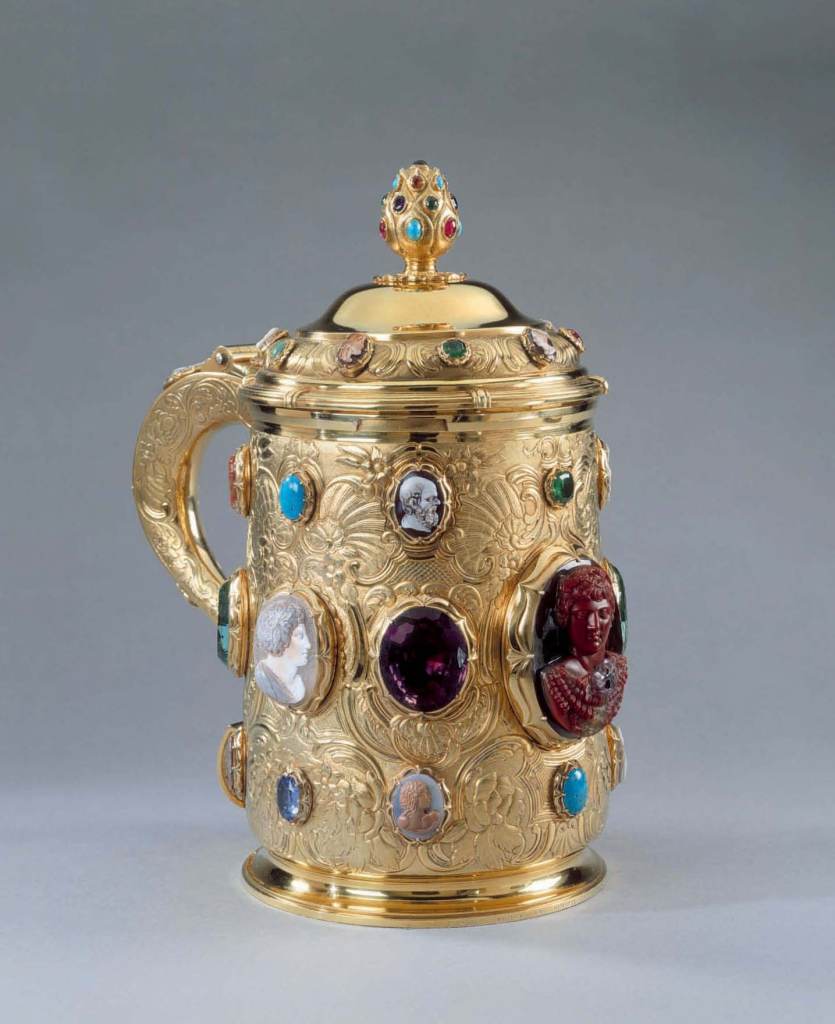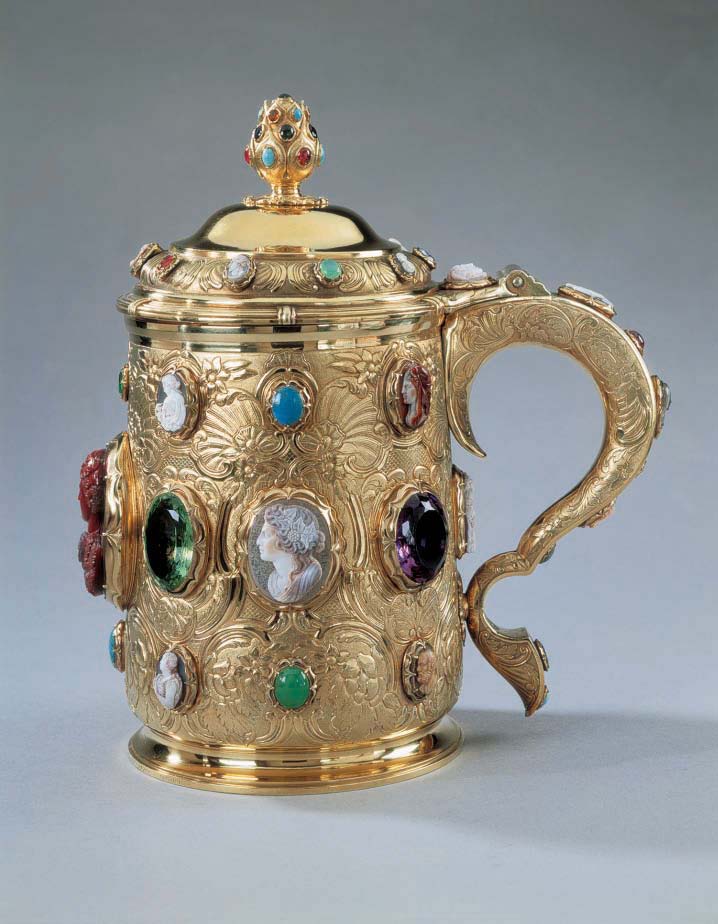Tankard in the Royal Collection Trust
Rundell, Bridge & Rundell, London, 1823 Silver-gilt, agate, onyx, sardonyx, jasper, amethyst, Siberian amethyst, chrysoprase, emeralds, ruby, Russian aquamarine, Russian green beryl, sapphires from Sri Lanka, pink sapphire, turquoises 27.7 × 27.5 × 16.0 cm; 10 7⁄8 × 10 13⁄16 × 6 5⁄8 in Fully struck with maker’s mark for John Bridge and London hallmarks for 1823–4; inscribed around the bottom rim: Rundell Bridge et Rundell, Aurifices Regis Londini RCIN 50608 PROVENANCE: Purchased by George IV from Rundell, Bridge & Rundell, 1823 INVENTORY REFERENCES: Rundells 1832, p. 39; Garrard 1914, no. 587 LITERATURE: Jones 1911, pl. xc111, no. 2; Carlton House 1991, no. 164; Royal Goldsmiths 2005, no. 49
Large silver-gilt lidded tankard embossed with rocaille work. The pine-cone-shaped finial is set with small cabochon amethysts, emeralds, hessonite garnets, rubies and turquoise. On the lid are five cameos alternating with Sri Lankan sapphire, chrysoprase, emerald, ruby and turquoise; on the handle are four cameos with a pink sapphire, emerald, sapphire and turquoise.
The main body of the tankard has three rows of cameos with four in each row alternating with green beryl, Siberian amethyst, turquoises, Sri Lankan sapphire (seventeenth-century cut), emerald and chrysoprase; the central cameos are large. The cameos on the lid in anti-clockwise sequence starting from the handle are as follows: (1) female head in profile to the right, onyx (from Saxony): white on grey with red speckles; (2) head of Hercules with beard in profile to the right, banded agate: brown and white (this image is similar to no. 38); (3) Sabina or Julia Titi (?) in profile to the left, sardonyx (from Saxony), pink on brown speckled red; (4) female head in profile to the left, onyx: white on grey; (5) female bust, one breast bare, in profile to the left, onyx: pinkish-white on grey.
On the handle from top to bottom: (1) Medusa head in frontal view, onyx: white on translucent white (on the bridge above the handle); (2) Hercules fighting the wild boar, sardonyx: white on dark brown with white spots; (3) bust of the Virgin in front view, banded agate: black and white; (4) veiled female in profile to the left, sardonyx: orange-brown and white.
On the main body of the tankard, anti-clockwise, starting from the handle, top row: (1) head of Minerva in profile to the right, sardonyx: red on light brown; (2) head of Socrates, or Diogenes, in profile to the right, onyx (from Saxony): white on dark brown with red specks; (3) bust of Cleopatra in profile to the left, onyx: white on grey; (4) female head with a cap in profile to the left, sardonyx: reddish-brown white on reddish-brown.
On the main body of the tankard, anti-clockwise, starting from the handle, central row: (1) bust of a bacchante in profile to the right, agate: light brown and white on quartz background; (2) bust of Meleager with a vine-wreath, wearing the hide of the boar, in three-quarter profile to the left, layered jasper and agate; (3) bust of a bacchante facing left, banded agate: grey-white and brown; (4) Judith with the head of Holofernes, accompanied by a servant brandishing the sword, sardonyx: orange-brown and white.
On the main body of the tankard, anti-clockwise, starting from the handle, bottom row: (1) head of Paris in profile to the right, wearing a phrygian cap, sardonyx: light brown, grey and brown; (2) bust of Hylos (?) in profile to the right, sardonyx
light brown on grey; (3) female bust in profile to the left with one arm along the lower edge, onyx: white on grey; (4) Socrates (?) in profile to the left, bald and bearded, sardonyx: light brown on brown.
This tankard was described as ‘a superb silver Tankard, richly set with Gems, Cameos and Intaglios and coloured stones gilt all over dead red’ when it was purchased by George IV for £504 from Rundell, Bridge & Rundell on 31 December 1823 (ra geo/26304).
The piece is a late example of the fashion for cameo-studded cups and covers. These were frequently produced in the seventeenth century in France and Flanders, and in Dresden in the early eighteenth century. Johann Melchior Dinglinger, the Dresden court jeweller, had the gem collection of Augustus the Strong at his disposal.
It is possible that Rundell, Bridge & Rundell similarly employed stones already in the Royal Collection and pieces that they had previously sold to George IV. It is tempting to suggest that the cameo heads of Diogenes and Socrates are from the Smith collection (Gori 1767, pls. xlv and xlv1; also ‘Hippocrates’, pl. xl111). However, it is difficult to be certain as the subjects were popular and the general likeness of the images can be misleading.
The cameos set on the tankard are mainly sixteenth century or later replicas. Notable exceptions include the unusual Judith and Holofernes, of the first half of the sixteenth century, and three early nineteenth-century gems. It is interesting to note that the goldsmith placed the cameos of his own period in prominent positions – in the central row of the vessel.
Of the three large cameos, that of Meleager recalls an Antinous by Giuseppe Girometti (1780–1854), who was in London after 1814; the large bacchante, in profile to the right, is in the manner of Niccolò Morelli (1771–1838), whereas the other bacchante is closer to Nicolò Amastini (1780–1851). A year after no. 328 was made, Rundells supplied the National Cup to George IV (rcin 50558).
After a design by John Flaxman (1755–1826), that cup similarly features multi-coloured gemstones as decorative elements. However, Gothic tendrils have replaced the rocailles, and there are no cameos: their moment had passed.





